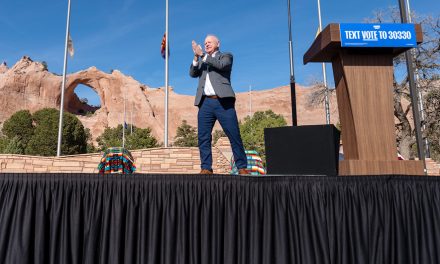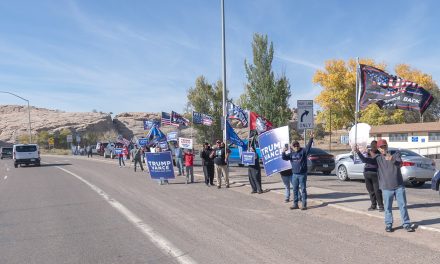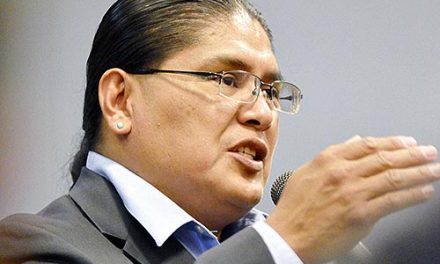
50 Years Ago: Judge orders Diné off disputed land
As Raymond Nakai continued campaigning for re-election as tribal chairman and claiming he had been the most effective leader in the tribe’s history, a scandal erupted. Leo Watchman, the tribe’s treasurer, announced the last week in April 1970 that he was leaving his position.
When asked by the Times why he had resigned, Watchman said, “Everyone knows why.” This was actually Watchman’s second tour of duty as tribal treasurer. He had held that position briefly in the early 1960s and had agreed to step into the position again when tribal officials agreed that they would not, in his words, play games with tribal funds.
The tribal treasurer was the top financial official within the tribal government. He was in charge of approving all of the checks issued by the tribe as well as making sure that all tribal laws were followed. In his first go-around, Watchman claimed Nakai supporters were given preference over non-supporters when it came time to decide who qualified for tribal benefits.
His first resignation resulted in the members of the tribal council taking a more supervisory role in tribal finance matters. In June 1968 he was enticed by the council’s Finance Committee to become treasurer again.
By then Watchman, who was also elected to be a state representative in New Mexico, had obtained a reputation of being that rare politician who was known for his honesty and refusal to use his position for his own personal benefit. A couple of days after he resigned, he was visited at his home by Dick Hardwick, the general manager of the Times.
Hardwick said the two had been friends for a long time and Hardwick wanted to see how he was doing. During the conversation, Hardwick said Watchman had gone into a little more detail about his reason for resigning. “We agreed when I accepted this position this time, he (Nakai) would not put a ring in my nose,” Watchman said, meaning that he would be allowed to run the department in his own way and would not have to follow the dictates of Nakai or any of his staff.
In recent weeks, probably to make sure that Nakai got as much support as possible for his re-election, Watchman began receiving orders to make sure that certain people were paid promptly and qualified for tribal funds. Watchman said he immediately saw where this was going and resigned. His resignation would take effect on May 16, giving him three weeks to tie up loose ends and help train someone to take over for him.
The big news that week, however, was the reaction of tribal leaders and members to a decision reached by U.S. District Court Judge Walter Craig ordering 12 Navajo families living on land claimed by the Hopis to be removed. Craig was the judge based in Phoenix overseeing the land dispute between the two tribes over 1.8 million acres north and west of the Hopi Reservation that on most maps was part of the Navajo Reservation.
The two tribes had been involved in a legal battle over that land for more than a decade. Navajo officials, as well as U.S. Sen. Barry Goldwater, who supported the Hopi position, had been saying that no matter what occurs in the courtroom or in Congress, no Navajo family would ever be forced to leave their ancestral home.
Craig’s ruling, which was seen as the first step to calling for removal of all Navajo, showed that the land dispute had entered a different and scary dimension. Craig stayed his ruling for 60 days in order to allow tribal attorneys a chance to file an appeal. The ruling was based on a 1958 decision by a three-man federal panel who ruled that the Hopis had a right to the land since it was given to them by President Chester A, Arthur in 1888. So as far as the courts were concerned, the hundreds of Navajos living on the land were trespassers.
If the Craig decision wasn’t bad enough, another federal judge in Tucson, James Walsh, had been tasked with coming up with the procedure to get the Navajos off the land so it could be turned over to the Hopis. He was in the process of holding hearings and working with officials of the BIA to figure out a way to accomplish this without having anyone resort to violence.
Walsh admitted that when he came into this and realized there was a good chance hundreds of Navajo families would have to be relocated, he thought that given the size of the reservation —12 million acres or a land base roughly the size of West Virginia — it would be easy just to move the families into areas of sparse population which basically existed throughout the reservation.
It was explained to him by Navajo leaders as well as federal officials who had an understanding of Navajo culture that every inch of reservation land had been allocated to families through grazing rights and any attempt to take parts of those rights away to provide a home for the relocated families would cause a revolt.
So Walsh was leaning toward a solution that would require the federal government to basically set these families up in areas off the reservation but still close enough so that they would maintain some relationship with their culture. He realized immediately that this would be an expensive solution given the fact that it was common for two or more generations to live together on the same section of land.
This would mean that instead of finding one home to relocate the families, the government would have to come up with the funds to purchase two or more homes. And since these homes would probably be in towns or rural settings with no land for grazing, the government would have to find a way to make up for the money they would lose by no longer being able to raise sheep. It was a problem that would take him years to resolve and it still has ramifications even today, some 50 years later.










 Highway 264,
Highway 264, I-40, WB @ Winslow
I-40, WB @ Winslow